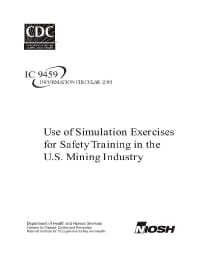Mining Publication: Use of Simulation Exercises for Safety Training in the U.S. Mining Industry
Original creation date: September 2001
Authors: HP Cole, WJ Wiehagen, C Vaught, BS Mills
NIOSHTIC2 Number: 20021605
Pittsburgh, PA: U.S. Department of Health and Human Services, Public Health Service, Centers for Disease Control and Prevention, National Institute for Occupational Safety and Health, DHHS (NIOSH) Publication No. 2001-141, Information Circular 9459, 2001 Sep; :1-20
This study reports the results of a survey of organizations that used problem-solving simulation exercises to support mine health and safety training. The exercises are designed to teach judgment and decision-making skills within two broad domains: (1) how miners respond to mine emergencies (e.g., first aid, self-rescue, and escape) and (2) how miners integrate safety concepts within the context and performance of routine production work. The simulation exercises were distributed by the Mine Safety and Health Administration's National Mine Health and Safety Academy near Beckley, WV. The present study focused on those organizations that ordered the exercises from the Academy over a 2-year period (1995-96). Researchers assessed how the materials were used and trainer perceptions of the impact of these materials on annual mine health and safety training.
A total of 147 organizations ordered the exercises over the 2-year period. Survey responses were obtained from 52 of these organizations. Sixty percent of the respondents rated the exercises as more useful than traditional instructional materials, 40% as equally useful, and 0% as less useful. Most trainers (79%) felt that the exercises help them to make better use of workers' knowledge and experience during training. Many (71%) also reported that the simulations helped to improve the effectiveness of their instruction and promoted a problem-solving approach to their training. Fifty of the fifty-two respondents reported that they would like to have new simulations developed. A large majority showed a proactive interest in helping to develop and field test new exercises. Ninety-four percent of the trainers judged the exercises as a good value; 92% planned to order more simulations in the future. Based on this study, recommendations are offered for the continuation and expansion of simulation exercises as one method for occupational health and safety training.

NIOSHTIC2 Number: 20021605
Pittsburgh, PA: U.S. Department of Health and Human Services, Public Health Service, Centers for Disease Control and Prevention, National Institute for Occupational Safety and Health, DHHS (NIOSH) Publication No. 2001-141, Information Circular 9459, 2001 Sep; :1-20
- Assessing and Evaluating Human Systems Integration Needs in Mining
- Considerations in Training On-the-Job Trainers
- Developing a Playbook on Powered Haulage Safety
- The Modern Evolution of Hearing Conservation Regulations
- Optimizing Secondary Roof Support with the NIOSH Support Technology Optimization Program (STOP)
- Technology News 513 - Coaching Workshop for On-the-Job Trainers
- Toolbox Training For Construction Aggregate Miners
- Toolbox Training on Flyrock Awareness
- When Do You Take Refuge? Decisionmaking During Mine Emergency Escape
- Workplace Perceptions of Safety